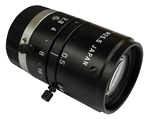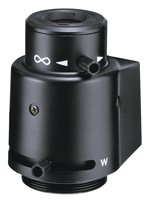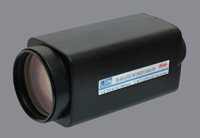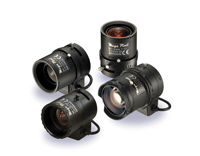Life through the lens – 3.
We continue the TZ review of lenses used for video surveillance cameras, which was started in previous issues (No. 6-2008 and 1-2009).
Today we will consider megapixel lenses: their features, main characteristics and areas of application.
Megapixel lenses have become popular with the advent of network megapixel cameras, new image compression formats, and the ability to transmit video information over a network. All of this has predetermined the appearance of qualitatively new optics on the CCTV market.
Megapixel lenses are high-definition lenses, and the cameras provide a clear image not only in the center, but also in the corners of the picture.
The lenses provide full resolution of megapixel cameras, high contrast. This is achieved primarily by the quality of all lens elements. Products from leading manufacturers, as a rule, use only glass lenses, and the finest grinding.
Meticulous selection, combination of lenses with spherical and aspherical surfaces, careful calculation and precision of mechanical design — all this minimizes possible geometric and chromatic aberrations. Another important feature of megapixel lenses is their robust housings, the use of which allows to significantly reduce the sensitivity of products to vibration, impacts, and fluctuations in ambient temperature.
The wide aperture of megapixel lenses allows for clear images in low light conditions. In addition, these lenses provide high image recognition accuracy, which is achieved by reducing the level of distortion and improving the uniformity of illumination transmitted to the CCD sensor. Megapixel lens lines from leading manufacturers usually include products with different focal lengths.
At the same time, many models of lenses with a small focal length have a viewing angle wide enough to be successfully used in cameras included in a video surveillance system that is equipped with large areas.
Megapixel lenses are an effective solution for a wide variety of video surveillance systems that use megapixel cameras from different manufacturers.
Today, there are practically no problems in the market with choosing the lens needed for effective camera operation. Readers can see this for themselves by reviewing the models presented in the review.
Varifocal megapixel lens with IR correction H3Z4518CS-MPIR (Computar)
The lens has a focal length of 4.5–13.2 mm, a resolution of 3 megapixels, and a 1/2” format with a CS thread. The lens is fully compatible with day/night cameras. Computar megapixel lenses are designed for high-definition security video surveillance systems with megapixel and other IP cameras. They are also used with cameras for machine vision systems, automated control, identification, measurement, positioning, and other areas in production.
3-Mpix lens with a focal length of 50 mm POLARIS JHF50M (Spacecom)

The long-focus lens of the Spacecom brand is designed for installation on surveillance cameras with CCD matrices up to 3 megapixels and allows the most efficient use of their resolution, forming video without loss of quality. JHF50M has a focal length of 50 mm, a viewing angle of 10 ° and is installed on cameras with a matrix from 1/3 to 2/3 inches and a C-type mount.
Precise focusing of the lens and adjustment of the relative aperture are performed manually, and all settings are rigidly fixed. Due to the successful combination of convex and concave lenses in the design of POLARIS lenses, they allow the video camera to form a high-quality video image without geometric and chromatic aberrations. In addition, these lenses have compact dimensions of 29 x 38.5 mm and low weight, so their use will be most useful with increased requirements for compactness and aesthetic appearance of the installed equipment.

TVR0916HDDC Varifocal Megapixel Lens (Tokina)
The new model of the varifocal lens TVR0916HDDC (1/3, f=9–22 mm, F/1.6 DC) for a megapixel video camera with a non-standard range of angles from 13° to 30° allows even a 3-megapixel video camera to fully demonstrate its resolution capabilities. Thus, by installing a video camera with a TVR0916HDDC lens on the roof of a gas station at maximum zoom from a distance of 10 m, you can fit a refueling truck into the full screen of the monitor. Thus, monitoring the situation and recognizing vehicle license plates will not only help prevent thefts, but also attract more customers by, for example, distributing discounts for regular customers.
Motorized 30x optical zoom lens with multi-megapixel resolution LMZ1236AM (Kowa Company Ltd.)

The 30x optical zoom lens LMZ1236AM for 3- and 5-megapixel cameras features high optical resolution and aperture ratio, large zoom ratio and low geometric distortion.
The use of the most advanced optical technologies, as well as the use of lenses made of glass with ultra-low dispersion (XD-eXtra low Dispersion), allow obtaining the highest image quality (High End). 3-CAM DESIGN technology eliminates decentering of the optical elements of the lens and increases the reliability of its mechanical units during temperature fluctuations. Optical resolution in the center is up to 120 lines per 1 mm, at the edge — up to 100 lines per 1 mm. Format — 1/1.8 inches, focal length range 12-360 mm, relative aperture (F-number) — 2.6-22. Distortion in the WIDE position is 0.6%, in the TELE position — 0.38%. C/CS-mount type mount. ARD type Direct Drive and Video Drive.
Overall dimensions (width, height, length) 100 x 100 x 264 mm.
3-megapixel varifocal lenses for cameras with a 1/2″ matrix (Fujinon)
Two new varifocal CCTV lenses – DV3.4X3.8SA-1 with manual aperture adjustment; DV3.4X3.8SA-SA1 with automatic Direct Drive type – are designed for use with megapixel CCTV cameras with a 1/2″ matrix format. Such cameras are produced, for example, by such companies as Arecont Vision, Bosch, Ikegami, JVC, Panasonic and others.

A very useful advantage of these lenses is the extended range of focal lengths: 3.8~13.0 mm. This allows us to talk about the manufacturer's focus on the most popular segment of CCTV varifocal optics with focal lengths of 3.5~8.0 mm among Russian installers.
Both models have a C-mount, a metal flange (more reliable than plastic). Light intensity — from F1.4. The DV3.4X3.8SA-SA1 modification with Direct Drive auto diaphragm is supplied in two versions: with a standard ARD cable — 100 mm and with an extended one — 230 mm.
FLAT FIELD Megapixel Objectives (Tamron)
Flat Field megapixel lenses, designed for a real megapixel view, provide full megapixel resolution of the entire image, from the center to the corner.

The lenses can receive full information from the megapixel camera and maximize its performance. This is what allows the manufacturer to position their megapixel lenses as wide-angle — Flat Field (high resolution for the entire surface). The Flat Field megapixel lens line includes: M13VM (G) 246 1/3 f=2.4–6 mm F/1.2 CS mount, aspherical, megapixel. M13VM (G) 308 1/3 f=3.0–8mm F/1.0 CS mount, aspherical, megapixel M13VM (G) 550 1/3 f=5–50 mm F/1.4 CS mount, aspherical, megapixel M12VM (G) 412 1/2 f=4–12 mm F/1.4 C mount, aspherical, megapixel.
All models have versions with manual and auto aperture.
